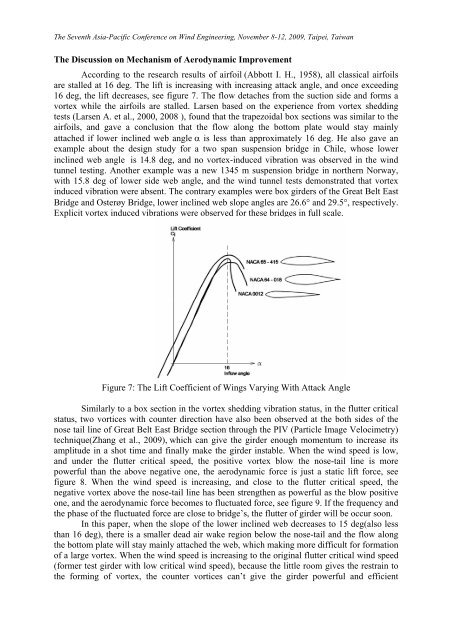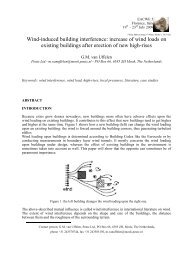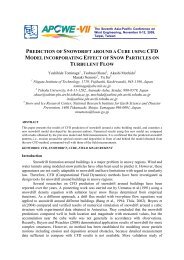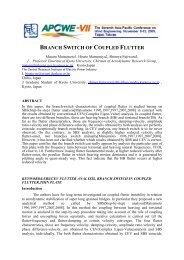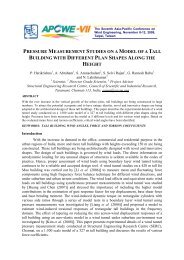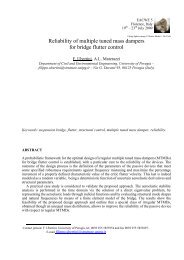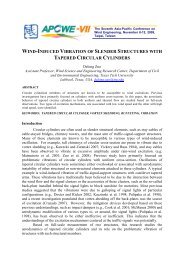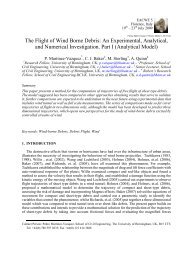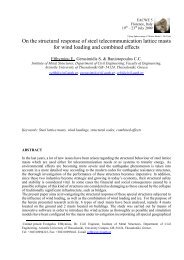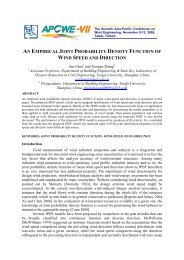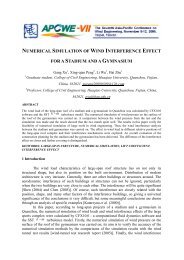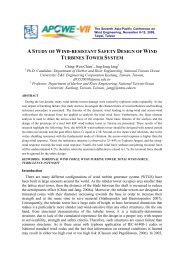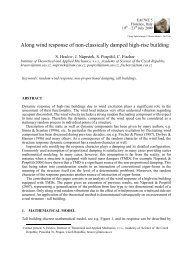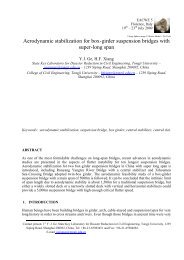wind tunnel study on aerodynamic optimization of suspension ...
wind tunnel study on aerodynamic optimization of suspension ...
wind tunnel study on aerodynamic optimization of suspension ...
Create successful ePaper yourself
Turn your PDF publications into a flip-book with our unique Google optimized e-Paper software.
The Seventh Asia-Pacific C<strong>on</strong>ference <strong>on</strong> Wind Engineering, November 8-12, 2009, Taipei, Taiwan<br />
The Discussi<strong>on</strong> <strong>on</strong> Mechanism <strong>of</strong> Aerodynamic Improvement<br />
According to the research results <strong>of</strong> airfoil (Abbott I. H., 1958), all classical airfoils<br />
are stalled at 16 deg. The lift is increasing with increasing attack angle, and <strong>on</strong>ce exceeding<br />
16 deg, the lift decreases, see figure 7. The flow detaches from the sucti<strong>on</strong> side and forms a<br />
vortex while the airfoils are stalled. Larsen based <strong>on</strong> the experience from vortex shedding<br />
tests (Larsen A. et al., 2000, 2008 ), found that the trapezoidal box secti<strong>on</strong>s was similar to the<br />
airfoils, and gave a c<strong>on</strong>clusi<strong>on</strong> that the flow al<strong>on</strong>g the bottom plate would stay mainly<br />
attached if lower inclined web angle α is less than approximately 16 deg. He also gave an<br />
example about the design <str<strong>on</strong>g>study</str<strong>on</strong>g> for a two span suspensi<strong>on</strong> bridge in Chile, whose lower<br />
inclined web angle is 14.8 deg, and no vortex-induced vibrati<strong>on</strong> was observed in the <str<strong>on</strong>g>wind</str<strong>on</strong>g><br />
<str<strong>on</strong>g>tunnel</str<strong>on</strong>g> testing. Another example was a new 1345 m suspensi<strong>on</strong> bridge in northern Norway,<br />
with 15.8 deg <strong>of</strong> lower side web angle, and the <str<strong>on</strong>g>wind</str<strong>on</strong>g> <str<strong>on</strong>g>tunnel</str<strong>on</strong>g> tests dem<strong>on</strong>strated that vortex<br />
induced vibrati<strong>on</strong> were absent. The c<strong>on</strong>trary examples were box girders <strong>of</strong> the Great Belt East<br />
Bridge and Osterøy Bridge, lower inclined web slope angles are 26.6° and 29.5°, respectively.<br />
Explicit vortex induced vibrati<strong>on</strong>s were observed for these bridges in full scale.<br />
Figure 7: The Lift Coefficient <strong>of</strong> Wings Varying With Attack Angle<br />
Similarly to a box secti<strong>on</strong> in the vortex shedding vibrati<strong>on</strong> status, in the flutter critical<br />
status, two vortices with counter directi<strong>on</strong> have also been observed at the both sides <strong>of</strong> the<br />
nose tail line <strong>of</strong> Great Belt East Bridge secti<strong>on</strong> through the PIV (Particle Image Velocimetry)<br />
technique(Zhang et al., 2009), which can give the girder enough momentum to increase its<br />
amplitude in a shot time and finally make the girder instable. When the <str<strong>on</strong>g>wind</str<strong>on</strong>g> speed is low,<br />
and under the flutter critical speed, the positive vortex blow the nose-tail line is more<br />
powerful than the above negative <strong>on</strong>e, the <strong>aerodynamic</strong> force is just a static lift force, see<br />
figure 8. When the <str<strong>on</strong>g>wind</str<strong>on</strong>g> speed is increasing, and close to the flutter critical speed, the<br />
negative vortex above the nose-tail line has been strengthen as powerful as the blow positive<br />
<strong>on</strong>e, and the <strong>aerodynamic</strong> force becomes to fluctuated force, see figure 9. If the frequency and<br />
the phase <strong>of</strong> the fluctuated force are close to bridge’s, the flutter <strong>of</strong> girder will be occur so<strong>on</strong>.<br />
In this paper, when the slope <strong>of</strong> the lower inclined web decreases to 15 deg(also less<br />
than 16 deg), there is a smaller dead air wake regi<strong>on</strong> below the nose-tail and the flow al<strong>on</strong>g<br />
the bottom plate will stay mainly attached the web, which making more difficult for formati<strong>on</strong><br />
<strong>of</strong> a large vortex. When the <str<strong>on</strong>g>wind</str<strong>on</strong>g> speed is increasing to the original flutter critical <str<strong>on</strong>g>wind</str<strong>on</strong>g> speed<br />
(former test girder with low critical <str<strong>on</strong>g>wind</str<strong>on</strong>g> speed), because the little room gives the restrain to<br />
the forming <strong>of</strong> vortex, the counter vortices can’t give the girder powerful and efficient


